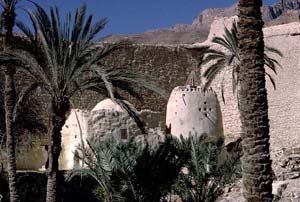|
The monastery of
Saint Paul
The monastery of St Paul has always been overshadowed by St
Anthonyís. Its titular founder was only sixteen when he fled
Alexandria to escape Emperor Deciusís persecutions, making him
the earliest known hermit. Shortly before his death in 348, Paul
was visited by Anthony and begged him to bring the rope of Pope
Athanasius, for Paul to be buried in. Anthony departed to fetch
this, but on the way back had a vision of Paulís soul being
carried up to heaven by angels and arrived to find him dead.
While Anthony was wondering what to do, two lions appeared and
dug a cave for the body, so Anthony shrouded it in the robe and
took Paulís tunic of palm leaves as a gift for the pope, who
subsequently wore it at Christmas, Epiphany and Easter.
 The monastery, called also Deir Anba Bula , was a form of
posthumous homage by Paulís followers: its turreted walls are
built around the cave where he lived for decades. To a large
extent, its fortunes have followed those of its more prestigious
neighbour. In 1484 all its monks were slain by the Bedouin, who
occupied St Paulís for eighty years, rebuilt by Patriarch
Gabriel VII, it was again destroyed near the end of the
sixteenth century.
The monastery is smaller than that of St Anthony and a little
more primitive-looking. In its main church of St Paul, the
murals, too, are less fluid Ė though better preserved. The
southern sanctuary of the larger Church of St Michael contains a
gilded icon of the head of John the Baptist on a dish. When
Bedouin raided the monastery, its monks retreated into the
five-storey keep, supplied with spring water by a hidden canal.
Nowadays this is not enough to sustain the seventy-old monks and
their guests, so water is brought in from outside. The monastery, called also Deir Anba Bula , was a form of
posthumous homage by Paulís followers: its turreted walls are
built around the cave where he lived for decades. To a large
extent, its fortunes have followed those of its more prestigious
neighbour. In 1484 all its monks were slain by the Bedouin, who
occupied St Paulís for eighty years, rebuilt by Patriarch
Gabriel VII, it was again destroyed near the end of the
sixteenth century.
The monastery is smaller than that of St Anthony and a little
more primitive-looking. In its main church of St Paul, the
murals, too, are less fluid Ė though better preserved. The
southern sanctuary of the larger Church of St Michael contains a
gilded icon of the head of John the Baptist on a dish. When
Bedouin raided the monastery, its monks retreated into the
five-storey keep, supplied with spring water by a hidden canal.
Nowadays this is not enough to sustain the seventy-old monks and
their guests, so water is brought in from outside. |